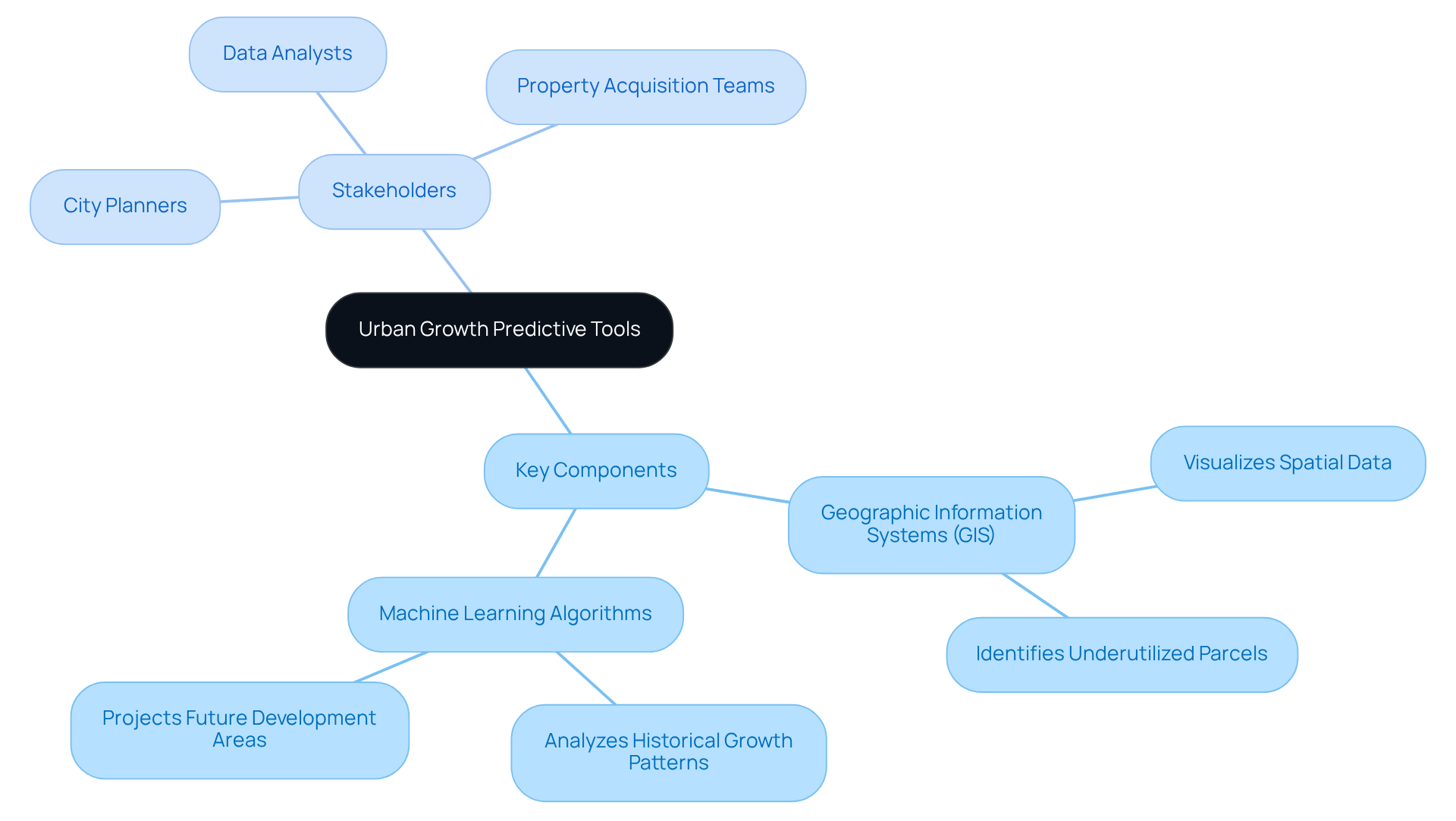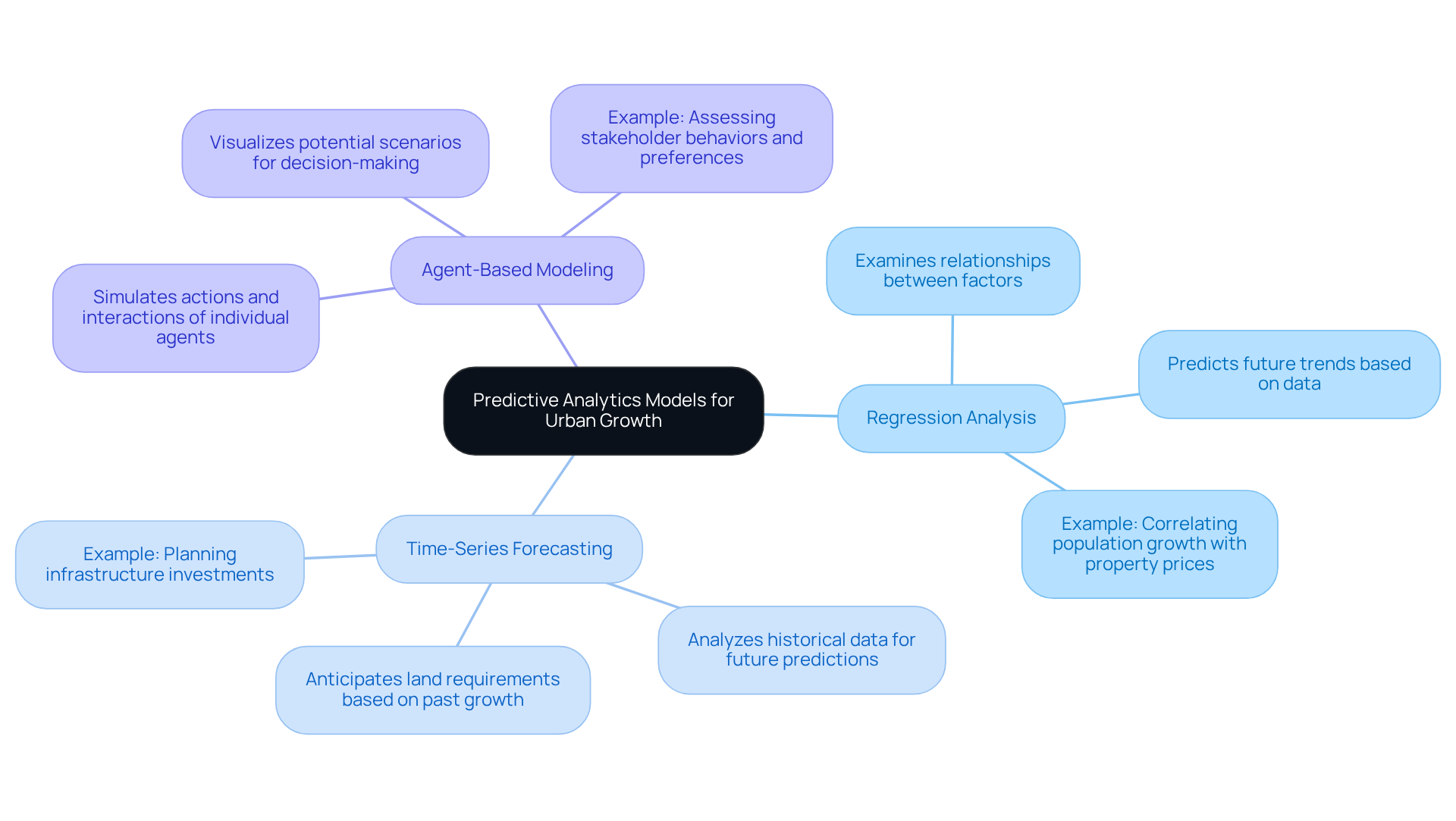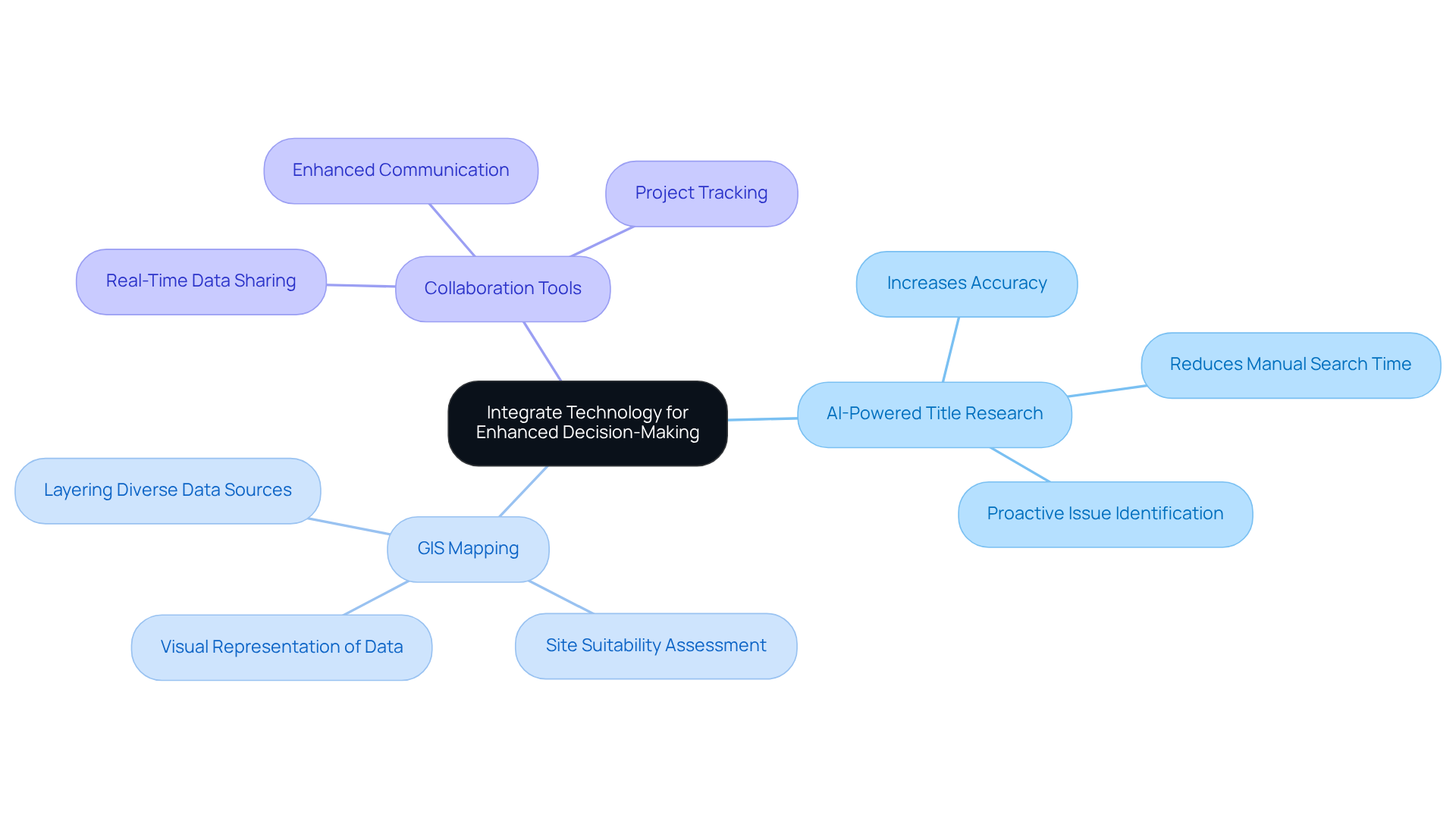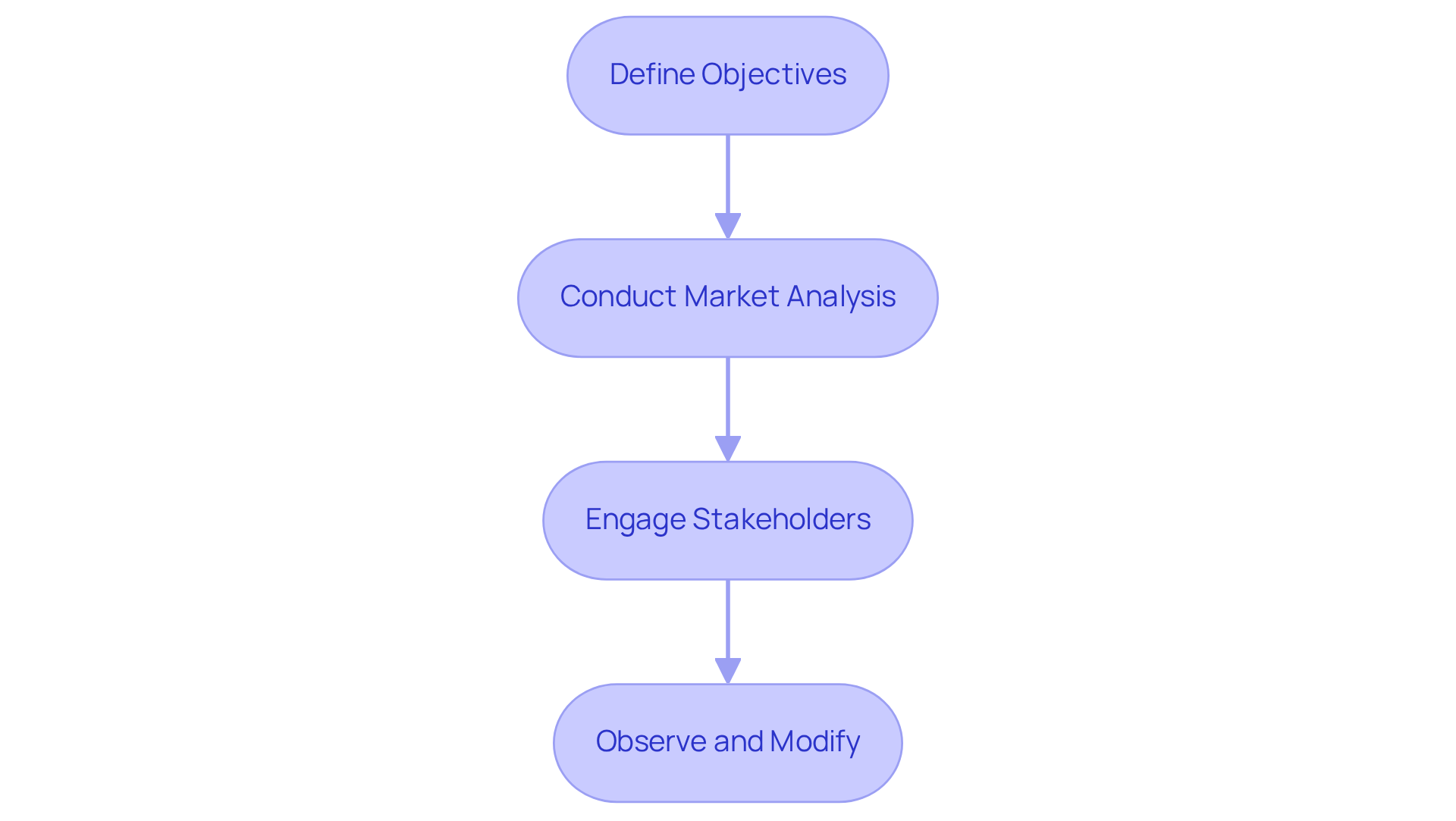Overview
Urban growth predictive tools are crucial for effective land acquisition, enabling organizations to forecast urban expansion and identify optimal development areas through advanced data analysis and modeling techniques. These tools address the complexities of land acquisition, including legal and regulatory challenges, thereby enhancing strategic planning.
The integration of various predictive models, such as GIS and machine learning, is emphasized, alongside the necessity for collaboration among stakeholders. This approach not only aligns property procurement with projected urban development trends but also fosters a comprehensive understanding of the evolving landscape.
By leveraging these predictive capabilities, organizations can navigate the intricacies of urban growth, ensuring informed decision-making and effective resource allocation.
Introduction
Urban centers are rapidly evolving, making the ability to predict their growth a critical asset for organizations involved in land acquisition. Predictive tools for urban growth leverage advanced data analysis and modeling techniques to forecast expansion patterns. This capability enables stakeholders to make informed decisions regarding property procurement.
However, how can these tools be effectively integrated into strategic planning, and what challenges might arise in their application? A thorough exploration of these predictive models reveals not only their potential benefits but also the complexities inherent in navigating urban development within a dynamic landscape.
Understand Urban Growth Predictive Tools
Urban growth predictive tools are essential for organizations involved in property acquisition, particularly within the energy and infrastructure sectors. Urban growth predictive tools leverage data analysis and modeling techniques to predict urban expansion and identify potential areas for development. By understanding these tools, stakeholders can more effectively assess resource availability, zoning regulations, and demographic trends that influence land use.
Key components of urban growth predictive tools include:
- Geographic Information Systems (GIS), which visualize spatial data
- Machine learning algorithms that analyze historical growth patterns
For instance, GIS can help identify underutilized parcels suitable for new projects, while machine learning can project future development areas based on current trends.
The effective use of these tools requires collaboration among various stakeholders, including:
- City planners
- Property acquisition teams
- Data analysts
By fostering a multidisciplinary approach, organizations can enhance their strategic planning efforts, ensuring property procurement is aligned with projected urban development trends.

Explore Predictive Analytics Models for Urban Growth
Urban growth predictive tools play a pivotal role in forecasting city development, empowering organizations to make informed decisions regarding property acquisition. Common models include regression analysis, time-series forecasting, and agent-based modeling. Each of these models offers distinct insights into urban dynamics and can be customized to meet specific project needs.
-
Regression Analysis: This model examines the relationship between various factors, such as population growth and property prices, to predict future trends. For instance, a natural gas firm may employ regression analysis to determine how population increases in a region correlate with rising property costs, aiding them in pinpointing optimal purchasing times.
-
Time-Series Forecasting: This method evaluates historical data to forecast future growth patterns. By analyzing past city expansion rates, organizations can anticipate future land requirements and adjust their acquisition strategies accordingly. For example, municipalities can leverage time-series data to plan infrastructure investments in anticipation of urban growth.
-
Agent-Based Modeling: This sophisticated model simulates the actions and interactions of individual agents (e.g., residents, businesses) to assess their impact on city development. By utilizing agent-based modeling, organizations can visualize potential scenarios and make informed decisions regarding property procurement that consider stakeholder behaviors and preferences.
To effectively implement these predictive analytics models, organizations should prioritize training for their teams and explore partnerships with data analytics firms. By integrating urban growth predictive tools into their property procurement processes, they can enhance their strategic planning and ensure alignment with future urban development trajectories.

Integrate Technology for Enhanced Decision-Making
The integration of technology into property procurement processes presents a transformative opportunity to enhance decision-making capabilities. Advanced tools, such as AI-powered title research software and GIS applications, not only streamline workflows but also significantly improve data accuracy.
-
AI-Powered Title Research: The utilization of AI in title research can drastically reduce the time dedicated to manual searches while increasing the accuracy of findings. For instance, AI algorithms can swiftly analyze extensive volumes of data to identify potential title issues, empowering property procurement teams to address them proactively.
-
GIS Mapping: Geographic Information Systems (GIS) provide a visual representation of terrain data, enabling stakeholders to assess site suitability with ease. By layering diverse data sources—including zoning regulations, environmental constraints, and demographic information—organizations can make informed decisions regarding property procurement.
-
Collaboration Tools: The implementation of collaborative platforms can significantly enhance communication among team members and stakeholders. Tools that facilitate real-time data sharing and project tracking ensure that all parties remain aligned and informed throughout the procurement process.
By embracing these technologies, organizations not only enhance operational efficiency but also bolster their capacity to respond to evolving market conditions and stakeholder demands. Training staff on these tools and fostering a culture of innovation will further facilitate successful technology integration.

Develop a Strategic Land Acquisition Plan
Developing a strategic property procurement plan is crucial for aligning with urban growth predictive tools and achieving organizational goals. This process entails several essential steps that can significantly enhance the effectiveness of land acquisition efforts.
-
Define Objectives: Begin by clearly outlining the goals of the land procurement process. This includes establishing timelines, budget constraints, and specific project requirements. Such clarity provides a solid framework for decision-making and prioritization, ensuring that all efforts are aligned with overarching objectives.
-
Conduct Market Analysis: Next, utilize urban growth predictive tools to analyze market trends and identify potential areas for investment. This analysis should encompass factors such as population growth, economic development, and infrastructure needs. Understanding these dynamics is vital for making informed investment decisions.
-
Engage Stakeholders: Collaboration is key. Engage with relevant parties, including local governments, community organizations, and industry partners, to gather insights and build support for procurement efforts. Early stakeholder engagement can help mitigate potential conflicts and streamline the approval process, fostering a more collaborative environment.
-
Observe and Modify: Finally, continuously observe urban growth patterns and be prepared to modify the purchasing plan as necessary. This adaptive approach ensures that organizations remain responsive to changing conditions and can capitalize on emerging opportunities.
By following these steps, organizations can establish a robust land acquisition strategy that utilizes urban growth predictive tools to address current needs and anticipate future demands. This proactive approach ultimately leads to more successful project outcomes.

Conclusion
Urban growth predictive tools are indispensable for organizations aiming to optimize their property acquisition strategies, especially within the energy and infrastructure sectors. By harnessing advanced data analysis and modeling techniques, these tools enable stakeholders to make informed decisions that resonate with urban expansion trends, thereby enhancing resource allocation and strategic planning.
This article underscores several key components and methodologies that are integral to urban growth predictive tools, including:
- Geographic Information Systems (GIS)
- Machine learning algorithms
- Various predictive analytics models such as regression analysis and agent-based modeling
Each of these elements plays a crucial role in fostering a comprehensive understanding of urban dynamics, empowering organizations to pinpoint potential development areas and make proactive land acquisition decisions.
As urban environments continue to transform, the adoption of these predictive tools becomes increasingly essential. Organizations are urged to invest in technology integration, foster multidisciplinary collaboration, and remain adaptable to market fluctuations. By doing so, they not only improve their operational effectiveness but also position themselves to seize future growth opportunities, ensuring that their land acquisition strategies remain relevant and impactful amidst an ever-evolving landscape.
Frequently Asked Questions
What are urban growth predictive tools?
Urban growth predictive tools are data analysis and modeling techniques used to predict urban expansion and identify potential areas for development, particularly in property acquisition within the energy and infrastructure sectors.
Why are urban growth predictive tools important?
They help organizations assess resource availability, zoning regulations, and demographic trends that influence land use, enabling more effective strategic planning for property acquisition.
What are the key components of urban growth predictive tools?
The key components include Geographic Information Systems (GIS) for visualizing spatial data and machine learning algorithms that analyze historical growth patterns.
How does GIS contribute to urban growth prediction?
GIS helps identify underutilized parcels that are suitable for new projects by visualizing spatial data.
What role do machine learning algorithms play in urban growth predictive tools?
Machine learning algorithms analyze historical growth patterns to project future development areas based on current trends.
Who are the stakeholders involved in using urban growth predictive tools?
Key stakeholders include city planners, property acquisition teams, and data analysts.
How can collaboration among stakeholders enhance the use of urban growth predictive tools?
Collaboration fosters a multidisciplinary approach that enhances strategic planning efforts, ensuring property procurement aligns with projected urban development trends.




